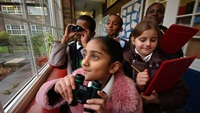
Started last 20 January, children across the UK will be taking part in the world’s biggest school wildlife survey. Around 75,000 students and teachers from 2,000 schools will be counting the birds that visit their grounds as part of the RSPB’s Big Schools’ Birdwatch. The survey, which has been running for more than a decade, helps to track bird numbers in schools, giving the charity’s experts an insight into populations and providing the children taking part with a great learning experience.

The results contribute to the charity’s Big Garden Birdwatch, which is the world’s biggest wildlife survey. Running from 20th January-14th February 2014, the survey encourages schoolchildren of all ages, and their teachers, to discover which birds they share their school grounds with and learn about their behaviour. The results help the RSPB build a picture of birds visiting school grounds and monitor any changes in the population.
Last year, participants discovered that for the fifth year running, the blackbird is the most commonly seen bird in school grounds with 89% of schools seeing an average of six. The starling took the second spot, with more than 40% of schools seeing an average of 4.2. And the black headed gull came third, knocking the woodpigeon off that spot from last year.
Suzanne Welch, the RSPB’s education manager, said: “For four weeks this winter, children gazing out of their classroom window will have a good excuse! Rather than daydreaming, it’s more likely they’ll be taking part in the RSPB’s Big Schools’ Birdwatch; watching to see what kinds of birds they can spot visiting their school grounds, then noting them down.
“Seeing it first hand is the single best way to enthuse young people about nature, and by watching birds from their classroom window they can learn so much.
“What is the slightly menacing looking, large black bird that keeps foraging under the bushes? Why do house sparrows always seem to stick together and appear in large groups? And why is the robin seemingly so much more confident and bolshie than the other, much bigger bird?
“These are all questions that children will ask and learning about birds’ behaviour gets them really excited about the world around them. And most importantly, it encourages them to want to contribute to giving nature a home.” [See note 1].
There’s still time for schools to sign up to take part in the Birdwatch.
Teachers, helpers or children don’t need to be experts to take part in the survey. Everything a teacher would need to plan a fantastic Birdwatch and develop their children’s knowledge and interest in the birds they see every day is available to download, including guidance notes, recipes, things to make and counting charts.
Suzanne added: “There’s plenty of flexibility for schools to run the survey as simply as they would like, or as the centrepiece of cross-curricular studies, project work or as part of work to improve their school grounds.
“It’s fun, easy and simple to set up, it works for all ages, and even it’s a dull, rainy January day you can still gaze out of classroom and see a flash of colour.”
The RSPB has also introduced the Little Schools’ Birdwatch, designed for 5s and under, and the Really Big Schools’ Birdwatch, for 11-14 year olds.
For further information and to get hold of a free Big Schools’ Little Schools’ or Really Big Schools’ Birdwatch teachers’ pack, visit rspb.org.uk/schoolswatch
The Big, Little and Really Big Schools’ Birdwatches are part of the world’s biggest birdwatching event; the RSPB’s Big Garden Birdwatch, which takes place over the weekend of 25/26 January 2014.
Further information can be found on the RSPB website
How you can help
Find out what birds are visiting your school grounds by getting involved in our annual Big Schools’ Birdwatch.
Source: RSPB – School Bell Rings to Mark the Start of World’s Biggest School Wildlife Survey





